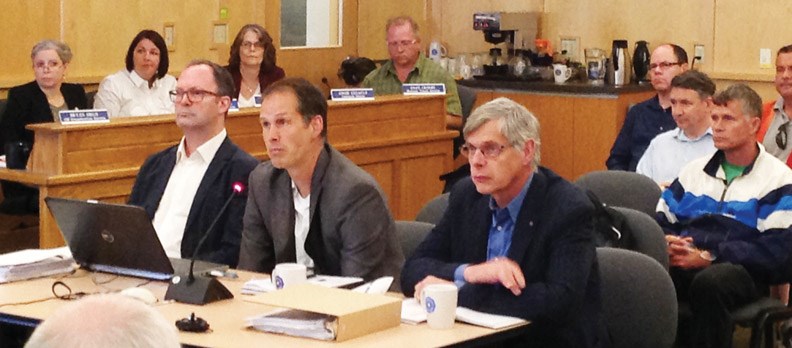Consultants with the firm AECOM have confirmed the Sunshine Coast Regional District’s (SCRD) Chapman Lake expansion project will take a year longer than hoped.
Project manager Brett DeWynter, environmental lead Bruce Ford, and consultation lead Andrew Mathewson appeared at a special meeting of the SCRD’s infrastructure services committee June 9.
DeWynter said, from an engineering standpoint, the project to deepen the outlet channel from Chapman Lake to allow the SCRD to draw more water in times of extreme drought isn’t very complex.
However, the remote location inside a provincial park boundary adds complications. Equipment will need to be brought in by helicopter, and the contractors may have to set up a work camp in the area. And it requires special permits.
According to DeWynter, BC Parks doesn’t feel it has enough information right now to consider those permits.
“There’s an additional piece that’s been added at the request of BC Parks,” he said. “There’s some additional environmental monitoring studies. That will be done this summer. We want to have approvals in place now no later than Nov. 15. Hopefully sooner, but no later than that.”
Ford described what BC Parks is looking for as a “vigorous environmental review,” and some of the fieldwork can only be done when the area is accessible in May, June or July. He said instead AECOM had to rely on existing information for an application to start construction this summer. Much of that information was from the so-called “Whitehead Report” drafted in the late ’90s for a proposed floating pump station on the lake.
“BC Parks is looking for more information,” Ford said. “They’re not really comfortable with the fact that most of the information we collected was collected back in 1998. They’re asking for more recent data to be incorporated into the environmental component of the submission.”
AECOM and BC Parks will, however, rely on a 2013 bathymetric (water depth and underwater characteristics) study. Ford said it shows an eight-metre drawdown of lake levels would still leave Chapman Lake’s depth at around 24 metres.
An archeological assessment was completed in late May. Other studies on construction impact will be done once a contractor is chosen.
The AECOM team also told the committee there is some upside to the delay. It could end up saving money, because companies bidding on the work won’t be faced with short timelines, which usually drive up costs. It will also allow more time for consultation.
Mathewson outlined how consultation has been handled so far with First Nations and the general public. He said the shíshálh Nation has been very active, but the company hasn’t had as much response from the Squamish Nation. He also said the groups consulted to date include the Sunshine Coast Conservation Association, Tetrahedron Outdoor Club, Salmonid Enhancement Society (and its Chapman Creek Hatchery), Tuwanek Ratepayers Association and the Ruby Lake Lagoon Society.
Some directors on the committee questioned why AECOM hadn’t talked to other groups.
Lorne Lewis of Elphinstone, who has consistently voted against the project, was one of them.
“We had a community association meeting last night [June 8] and one of the discussions was [around] why we’ve been totally ignored in this process, but I’m glad to hear you’ve got an extra year to get a hold of us,” said Lewis, adding, “We’d like to see you down on the south part of the Coast, OK. I will rent the hall, I’ll pay for everything. You show up. We’d like to have a candid talk.”
SCRD chair Garry Nohr, the director for Halfmoon Bay, questioned why advisory planning commissions (APCs) and other community associations hadn’t been involved yet.
“They’ve been left out of the communication,” he said. “Maybe an opportunity’s been missed that you might want to correct or move forward on … I think you’ve missed an opportunity there to really sell this program for us because there are some people that really have doubts and there’s myths out there, a lot of misinformation.”
Mathewson said the consultants are planning at least one public open house on the project this summer, on top of their meetings with community groups, local governments and other stakeholders.
“There are very open ears here in terms of what comes out of this [public] participation and the environmental pieces,” said committee chair Mark Lebbell of Roberts Creek. He was responding to questions from the public on what the SCRD would consider the bottom line when it comes to an environmental impact serious enough to call the project off. “At the same time we have a community that is, in terms of resilience – depending on where your definition of short is – getting short on water. Not just for drinking, but for fire protection and other uses as well.”
The SCRD is still planning to use a long-term loan to pay for the $5-million project, and an Alternative Approval Process (AAP) to get voter consent for that loan will go ahead as planned in June and July.



